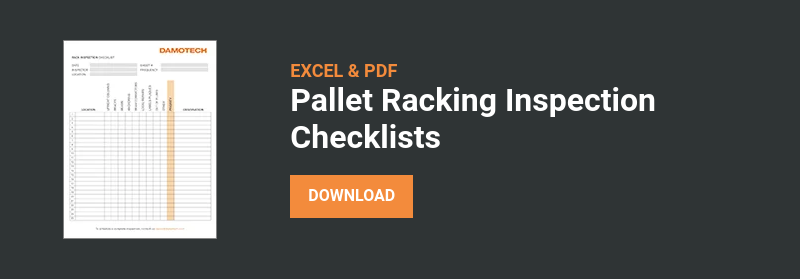In addition to ensuring the conformity of his pallet racks, an employer must also make sure that pallet loads and goods are stored in a way that prevents them from falling. This type of incident can occur because of damaged pallets, loose packaging, failure to securely place materials in the storage rack by forklift operators, or the inadvertent pushing of stored materials by operators too far out of the storage rack position into the adjacent aisle. Since pedestrians often use rack tunnels to travel from one aisle to another, I’ve often been asked:
Do you need wire mesh rack decking on every beam level in a rack tunnel?
The short answer is no. Typically, only the first beam level in a tunnel must have wire mesh rack decking to help catch any falling debris or product.
OSHA has issued very general regulations regarding the use of industrial shelving in the workplace. Article 1910.176(b) is the closest thing to apply to such a situation. Ultimately, it states that warehouse management is required to take all the necessary measures to protect workers. Using wire mesh rack decking on the first beam level of a rack tunnel is one way to help protect pedestrians.
Here is an excerpt of the article - OSHA 1910.176(b):
“…storage of material shall not create a hazard. Bags, containers, bundles, etc., stored in tiers shall be stacked, blocked, interlocked, and limited in height so that they are stable and secure against sliding or collapse.”
OSHA’s General Duty Clause, which requires an employer to offer a place of employment which is free from recognized hazards, provides a broader provision under which the agency can cite an employer for failure to prevent or correct a “recognized” hazard.
If we turn to the American National Standards Institute (ANSI) standards; MH16.1, the rack design code specified in the IBC – (International Building Code) which is applied in the US, it also says that protection may be required. Below are excerpts of the mentioned article:
8.4.5 Product Fall Protection:
The owner should specify to the designer any locations where operations may require horizontal or vertical safety barriers. These barriers shall prevent product from falling into those areas.
Again, it’s essentially up to the owner to recognize and prevent objects from falling.
From MH16.1 - 8.4.5 Product Fall Protection Commentary;
There also may need to be systems in place to protect areas within or around the structure from products that could accidentally fall. These locations may be areas where people could be or areas where falling product could cause other types of property damage or safety hazards. These areas should be identified by the owner and brought to the attention of the designer and proper barriers, if required, should be supplied and installed. These requirements will vary depending on the products, the operation and the configuration of the structure.
Now, you may be asking yourself if the wire mesh rack decking must be fixed to the rack beams?
Design codes ask for safety bars to be fixed to the beams (front and back) because they can move from side to side. However, there is no clear recommendation in the codes for wire mesh decking. We know that although waterfall type wire mesh will not laterally move and cannot just fall off the rack, it is better to attach them to beams as they sometimes can get lifted by pallets during handling operations.
Recommendations
There is no such thing as too much prevention. Regular inspections should be conducted to identify possible hazards, and the use of fall protection accessories such as safety bars and wire mesh rack decking can be used where objects could fall and potentially injure workers.







